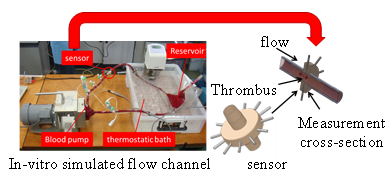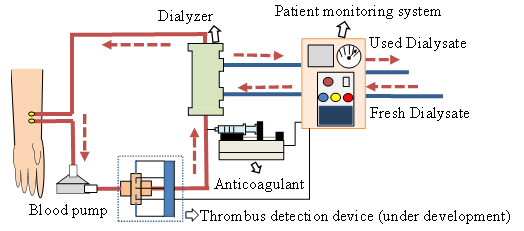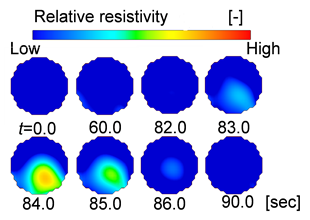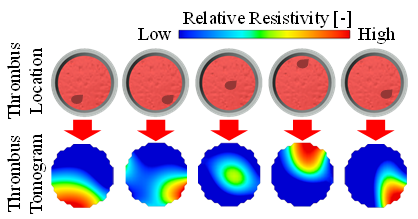Newsletter 2014.12 Index
Theme : "Mechanical Engineering Congress, 2014 Japan (MECJ-14) Part 2"
|
Possibility of Thrombus Detection in Extracorporeal Blood Flow Channel using Process Tomography
Achyut Sapkota
Takuto Fuse
Osamu Maruyama
Masahiro Takei
|
Abstract
The cardiovascular diseases are the major cause of the overall human death in Japan as well as globally. A lot of progress has been made in the development of artificial organs and extracorporeal circulation devices to assist the patients of chronic cardiovascular diseases. However, there is always a higher risk of thrombus formation in these devices. Hence, the real-time non-invasive or minimally invasive blood monitoring system is highly desirable for the reliable and safe treatment of the patients. The authors are currently developing the online blood monitoring sensor, as shown in Figure 1, to detect the thrombus in real time. This article presents the assessment of the real time visualization of the thrombus using process tomography method. Process tomography technique is a non-invasive measurement technique that produces a cross-sectional image showing the distribution of electrical resistivity or permittivity of the contents in the channel from the measurements taken at the channel boundary. As a feasibility study of the application of the process tomography technique for the online blood monitoring, the authors are investigating the various electrical properties (resistivity, permittivity, appropriate ac frequency etc) of blood and thrombus in various conditions to visualize the time of passage, location and size of the thrombi. Some of the results of the experiments carried out using bovine blood are presented in the article. The time of passage and location of the thrombi were characterized by the increased resistivity in the certain part of the cross-section. However, the sizes of the thrombi didn’t show good correlation with the resistivity. Instead, the sizes of the thrombi had good correlation with the change of permittivity. From this preliminary investigation, it can be concluded that it is possible to develop the online thrombus monitoring sensor by process tomography method by exploiting the electrical properties of the blood and thrombus. ツツツツツ
Key words
Process Tomography, Electrical Impedance, Blood Flow Visualization, Thrombus Detection, Extra-corporeal Circulation
Figures


Fig.1 Final goal

(a) Resistivity tomogram of settling thrombus

(b) Resistivity tomogram of thrombi at various cross-sectional position
Fig.2 Preliminary thrombi visualization results using process tomography method





